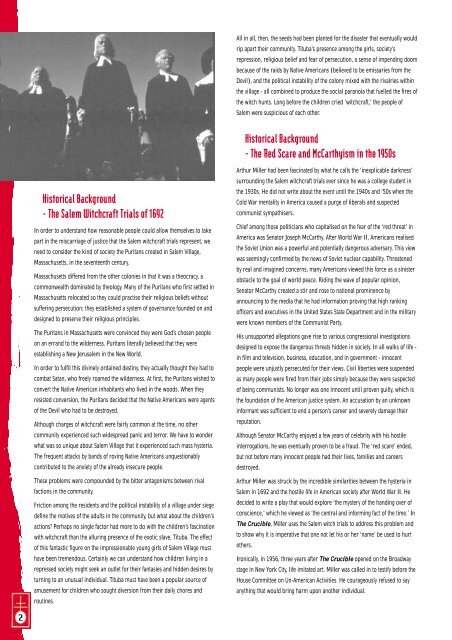The crucible - Saint Ignatius' Moodle Community
The crucible - Saint Ignatius' Moodle Community
The crucible - Saint Ignatius' Moodle Community
You also want an ePaper? Increase the reach of your titles
YUMPU automatically turns print PDFs into web optimized ePapers that Google loves.
All in all, then, the seeds had been planted for the disaster that eventually would<br />
rip apart their community. Tituba’s presence among the girls, society’s<br />
repression, religious belief and fear of persecution, a sense of impending doom<br />
because of the raids by Native Americans (believed to be emissaries from the<br />
Devil), and the political instability of the colony mixed with the rivalries within<br />
the village - all combined to produce the social paranoia that fuelled the fires of<br />
the witch hunts. Long before the children cried ‘witchcraft,’ the people of<br />
Salem were suspicious of each other.<br />
Historical Background<br />
- <strong>The</strong> Red Scare and McCarthyism in the 1950s<br />
2<br />
Historical Background<br />
- <strong>The</strong> Salem Witchcraft Trials of 1692<br />
In order to understand how reasonable people could allow themselves to take<br />
part in the miscarriage of justice that the Salem witchcraft trials represent, we<br />
need to consider the kind of society the Puritans created in Salem Village,<br />
Massachusetts, in the seventeenth century.<br />
Massachusetts differed from the other colonies in that it was a theocracy, a<br />
commonwealth dominated by theology. Many of the Puritans who first settled in<br />
Massachusetts relocated so they could practise their religious beliefs without<br />
suffering persecution; they established a system of governance founded on and<br />
designed to preserve their religious principles.<br />
<strong>The</strong> Puritans in Massachusetts were convinced they were God’s chosen people<br />
on an errand to the wilderness. Puritans literally believed that they were<br />
establishing a New Jerusalem in the New World.<br />
In order to fulfil this divinely ordained destiny, they actually thought they had to<br />
combat Satan, who freely roamed the wilderness. At first, the Puritans wished to<br />
convert the Native American inhabitants who lived in the woods. When they<br />
resisted conversion, the Puritans decided that the Native Americans were agents<br />
of the Devil who had to be destroyed.<br />
Although charges of witchcraft were fairly common at the time, no other<br />
community experienced such widespread panic and terror. We have to wonder<br />
what was so unique about Salem Village that it experienced such mass hysteria.<br />
<strong>The</strong> frequent attacks by bands of roving Native Americans unquestionably<br />
contributed to the anxiety of the already insecure people.<br />
<strong>The</strong>se problems were compounded by the bitter antagonisms between rival<br />
factions in the community.<br />
Friction among the residents and the political instability of a village under siege<br />
define the motives of the adults in the community, but what about the children’s<br />
actions? Perhaps no single factor had more to do with the children’s fascination<br />
with witchcraft than the alluring presence of the exotic slave, Tituba. <strong>The</strong> effect<br />
of this fantastic figure on the impressionable young girls of Salem Village must<br />
have been tremendous. Certainly we can understand how children living in a<br />
repressed society might seek an outlet for their fantasies and hidden desires by<br />
turning to an unusual individual. Tituba must have been a popular source of<br />
amusement for children who sought diversion from their daily chores and<br />
routines.<br />
Arthur Miller had been fascinated by what he calls the ‘inexplicable darkness’<br />
surrounding the Salem witchcraft trials ever since he was a college student in<br />
the 1930s. He did not write about the event until the 1940s and ’50s when the<br />
Cold War mentality in America caused a purge of liberals and suspected<br />
communist sympathisers.<br />
Chief among those politicians who capitalised on the fear of the ‘red threat’ in<br />
America was Senator Joseph McCarthy. After World War II, Americans realised<br />
the Soviet Union was a powerful and potentially dangerous adversary. This view<br />
was seemingly confirmed by the news of Soviet nuclear capability. Threatened<br />
by real and imagined concerns, many Americans viewed this force as a sinister<br />
obstacle to the goal of world peace. Riding the wave of popular opinion,<br />
Senator McCarthy created a stir and rose to national prominence by<br />
announcing to the media that he had information proving that high ranking<br />
officers and executives in the United States State Department and in the military<br />
were known members of the Communist Party.<br />
His unsupported allegations gave rise to various congressional investigations<br />
designed to expose the dangerous threats hidden in society. In all walks of life -<br />
in film and television, business, education, and in government - innocent<br />
people were unjustly persecuted for their views. Civil liberties were suspended<br />
as many people were fired from their jobs simply because they were suspected<br />
of being communists. No longer was one innocent until proven guilty, which is<br />
the foundation of the American justice system. An accusation by an unknown<br />
informant was sufficient to end a person’s career and severely damage their<br />
reputation.<br />
Although Senator McCarthy enjoyed a few years of celebrity with his hostile<br />
interrogations, he was eventually proven to be a fraud. <strong>The</strong> ‘red scare’ ended,<br />
but not before many innocent people had their lives, families and careers<br />
destroyed.<br />
Arthur Miller was struck by the incredible similarities between the hysteria in<br />
Salem in 1692 and the hostile life in American society after World War II. He<br />
decided to write a play that would explore ‘the mystery of the handing over of<br />
conscience,’ which he viewed as ‘the central and informing fact of the time.’ In<br />
<strong>The</strong> Crucible, Miller uses the Salem witch trials to address this problem and<br />
to show why it is imperative that one not let his or her ‘name’ be used to hurt<br />
others.<br />
Ironically, in 1956, three years after <strong>The</strong> Crucible opened on the Broadway<br />
stage in New York City, life imitated art. Miller was called in to testify before the<br />
House Committee on Un-American Activities. He courageously refused to say<br />
anything that would bring harm upon another individual.







